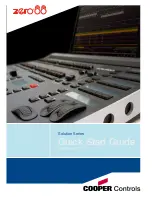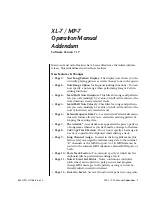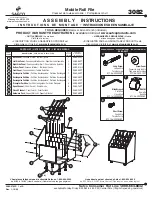
>@9
Multitone Audio Test System
User Manual
66 / 71
V
3.32
5 A
PPLICATION
H
INTS
>@9
is ideally suited to be integrated into industrial environments, having virtually no
switches and buttons. All control is established through IEEE commands, allowing to
introduce Audio tests as a standard part of the entire QC procedure.
Arbitrary Generator
With its flexibility, ease of operation and its excellent price/performance ratio,
>@9
can be
used as a simple arbitrary generator. This way, after few minutes of programming only,
>@9
can serve as a sine wave generator with one fixed, extremely stable frequency or as an IMD,
DFD or W&F generator with two frequencies defined. The four dual channel memory
locations also allow to have all these configurations permanently stored.
Alignment and Adjustments for Audio Repair Facilities
With the ability to plot two to three frequency responses every second, alignment sequences
for tapes, where they have to be done manually, or bias adjustments of amplifiers can be
speeded up. Repeated phase measurements simplify the alignment of the azimuth angle of
the playback head of a tape recorder - a procedure that normally has to be repetitively
performed for low-, mid- and high frequencies.
Cellular Phone Testing
Increasing production volume, based on the fast growth of cellular networks and coupled
with the requirement for 100% testing of the units, makes an improvement at production
bottleneck - the audio analysis - necessary.
>@9
is ideally suited to serve as a high-speed
audio analyzer for production testing. The LF- output signal of the system may be RF-
modulated and transmitted through an antenna, to quickly obtain the frequency response
and distortion in the voice band of the whole signal path. Frequency shifts as they may
appear on AM/FM transmissions are eliminated by the synchronization capabilities of
>@9
.
SINAD measurements with a single bin stimulus are possible down to a value of 1dB. The
trigger detection works reliably if the signal is transmitted on the second channel, too.
The dual channel capabilities of
>@9
even makes it possible to perform transmit and receive
testing simultaneously. One channel generates the source signal for the transmitter path of
the phone (Mic input), while an external test demodulator feeds back the signal to the
analyzer of the same channel. The output of the second channel is fed into an external
modulator, that supplies the RF signal for the receiver path of the phone. The phone
demodulates the signal and the feeds into the second analyzer channel of
>@9
.
Rub & Buzz Speaker Testing
The multitone feature of
>@9
is ideally suited for Rub & Buzz speaker testing in production
lines. Most frequently seen defects of speakers are mechanical friction of the moving coil
and the magnet, as well as excentrical alignments leading to a staggering movement of the
coil. In any of these cases, the speaker either starts to produce nonlinear distortion or adds
additional signal energy to frequencies not being part of the original signal. Both of these
effects can be measured in a fraction of a second. Harmonics and new frequencies will
appear in the distortion-, and in most cases in the noise-plot.
Anyway, the stimulation of a speaker with a multitone signal is more realistic and comes
closer to real-world signals. Actually, the mentioned effects may remain unnoticed when
stimulating with a single frequency only.






































